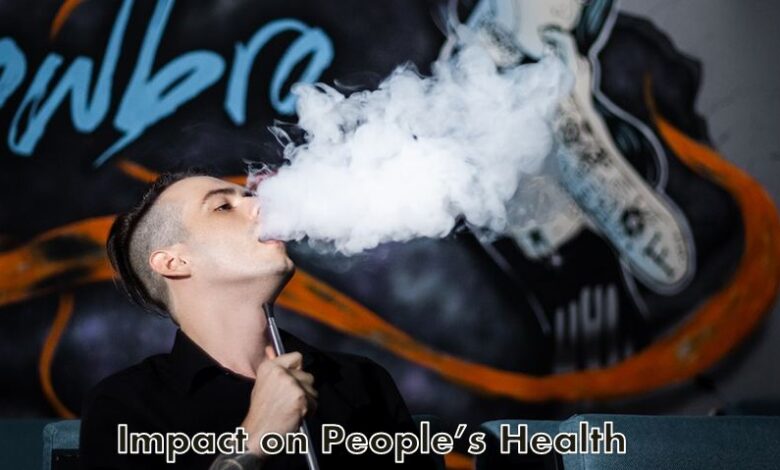Impact on People’s Health of Using Vape

Definition of Vaping
Vaping involves inhaling and exhaling aerosols, often referred to as vapor, produced by an electronic device called a vape. The vape device heats an e-liquid, which usually contains nicotine, flavorings, and other additives.
Rising Popularity of Vaping
The popularity of vaping has surged, especially among young people, as it is perceived as a trendy and modern way to consume nicotine.
Purpose of the Article
This article aims to provide an in-depth analysis of the health effects of vaping to help readers make informed decisions about their habits and lifestyle choices.
Understanding Vape Components
Vape Devices and E-liquids
Vape devices come in various shapes and sizes, ranging from simple disposable e-cigarettes to advanced mods and tanks. E-liquids, which are responsible for creating the vapor, consist of a combination of propylene glycol, vegetable glycerin, flavorings, and sometimes nicotine.
Nicotine and Other Additives
Nicotine, the primary addictive component in vapes, can have varying concentrations in e-liquids. Additionally, some e-liquids may contain other additives that enhance flavor or produce a specific effect when inhaled.
Short-Term Effects of Vaping on Health
Impact on the Respiratory System
Vaping can cause irritation to the respiratory system, leading to symptoms such as coughing, throat irritation, and shortness of breath.
Effects on Cardiovascular Health
Nicotine in vapes can temporarily increase heart rate and blood pressure, potentially putting strain on the cardiovascular system.
Potential Side Effects
In some cases, users may experience side effects such as nausea, dizziness, and headaches after vaping.
Long-Term Health Risks
Respiratory Issues and Lung Damage
Long-term vaping has been associated with respiratory issues, including bronchitis and even popcorn lung, a severe lung disease.
Cardiovascular Diseases
Continuous vaping may contribute to an increased risk of cardiovascular diseases, similar to traditional smoking.
Addiction and Dependency
Nicotine in vapes can lead to addiction and dependency, making it challenging for individuals to quit.
Vaping and the Youth
Appeal to Younger Audiences
Vape marketing and flavors can attract young people, potentially leading to nicotine addiction at an early age.
Impact on Brain Development
Vaping during adolescence may interfere with brain development, leading to long-term cognitive issues.
Comparing Vaping to Traditional Smoking
Harm Reduction Potential
Vaping is often considered a less harmful alternative to traditional smoking due to fewer harmful chemicals produced during combustion.
Nicotine Content and Delivery
Understanding nicotine delivery and consumption in vaping compared to traditional cigarettes.
Vaping and Mental Health
Potential Linkages to Anxiety and Depression
Some studies suggest a possible link between vaping and increased anxiety and depression.
Coping Mechanisms and Vape Usage
The use of vapes as coping mechanisms for stress and mental health issues.
Secondhand Vaping Exposure
Health Risks to Non-Vapers
Exposure to secondhand vape aerosols may pose health risks to those who do not vape.
Safety Concerns in Public Spaces
Debates over vaping regulations in public areas due to concerns about secondhand exposure.
Vaping Cessation and Support
Strategies for Quitting Vaping
Effective methods for individuals looking to quit vaping and overcome nicotine addiction.
Supportive Resources and Programs
The role of support groups and counseling in vaping cessation.
Regulation and Policy
Current Vape Regulations
An overview of current vaping regulations and laws in different regions.
The Role of Government and Advocacy
The importance of government intervention and advocacy in regulating vaping.
Vaping and Smoking Cessation
Effectiveness of Quitting Smoking
Examining the effectiveness of using vapes as a tool for smoking cessation.
Dual Use Concerns
Concerns about individuals using both cigarettes and vapes simultaneously.
Misconceptions about Vaping
Marketing Tactics and Misleading Claims
Critically evaluating marketing tactics and debunking misleading claims made by some vaping companies.
Debunking Myths
Addressing common misconceptions about vaping and its impact on health.
Promoting Awareness and Education
Public Health Campaigns
The role of public health campaigns in disseminating accurate information about vaping.
Targeted Messaging
Effectively reaching different audiences with tailored messages about the health risks of vaping.
Impact of Vaping on the Environment
Waste and Pollution Concerns
Discussing the environmental impact of discarded vape devices and e-liquids.
Sustainable Alternatives
Exploring eco-friendly options in the vaping industry.
Conclusion
In conclusion, vaping, while perceived as a less harmful alternative to smoking, still poses significant health risks. Short-term effects can include respiratory and cardiovascular issues, while long-term use may lead to severe lung damage and addiction. The impact on the youth, mental health, and secondhand exposure are also critical concerns. To promote better health outcomes, it is essential to address misconceptions, implement effective regulation, and support individuals in their efforts to quit vaping.






